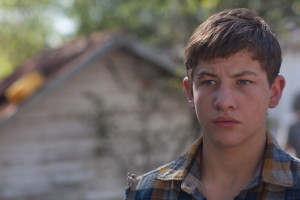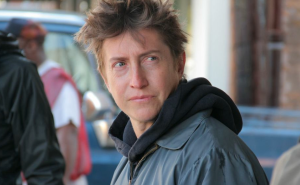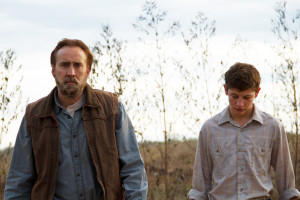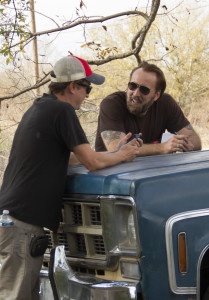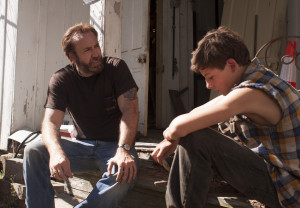Joe is a contemporary Southern Gothic story about a down-on-his-luck man named Joe (Nicolas Cage) who, having a regrettable history, is trying to distance himself from his troubled past. After meeting an equally troubled, but optimistic, adolescent named Gary (Tye Sheridan), Joe somewhat reluctantly serves the role of father figure, giving Gary a job amongst his crew of day laborers, protecting him from his abusive father (the late Gary Poulter) and teaching hard-living life lessons to a kid who’s already done a good bit of living himself. The film (now available on Blu-ray and DVD) is based on a novel by Larry Brown and became a film festival and art house favorite. Before the movie’s recent Atlanta Film Festival opening night screening, Wrestling with Pop Culture got to talk to Sheridan and director David Gordon Green about their powerful cinematic creation.
Tye, his is the second year in a row you had a pretty major film in the Atlanta Film Festival, and your roles in Mud and Joe were pretty similar. What attracts to these roles where you play adolescent characters that have already done a lot of living?
Sheridan: For a while the only thing I could get cast in was a Southern drama because people were like, “Ah, he has an accent. He won’t be able to do this film.” I was auditioning a lot, but these seemed to be the only films I was getting. But I really like these films because I was born and raised in Texas, my family’s from the South and I feel like I represent my family well. They like to see me in these films and it’s been fun.
As a director, what was it like directing a character like Gary?
Green: I’m always drawn to youthful roles. Most of my films have young characters in them and that’s something that’s always been appealing to me. When I saw Tye’s first performance in Terrence Malick’s The Tree of Life, it really caught my eye as somebody to watch out for. That was my favorite part of that movie was, as epic and spiritual as the movie got, for me it was kept grounded by this portrait of youth. I really loved what Tye did in that. Then I was in the editing room on Mud when Jeff [Nichols] was putting that together and I just watched as that movie was being assembled [and thought], “OK, he’s really taking the next step and becoming a strong young actor.”
It’s nice to have an actor with acting ability, but I certainly don’t need it. I’ve spent a lot of my career working with non-actors and nontraditional performers. Formal acting experience and training means very little to me. But finding the right face and voice means everything. I saw hundreds of kids that came in and auditioned … but what Tye had was the physicality, the life experience, the accent and he really understood the core of this character and could relate to not only the region where the character’s from, but how these domestic situations would affect a kid of that age realistically. That’s so much more important to me is an actor that brings you ideas and value rather than just memorize the script and tell you what you want to hear. This is a story based on the legendary Larry Brown’s wonderful piece of literature. But at the same time, a movie is a movie and we’re trying to find the naturalism and breath life into the words that are spoken, the images that are shot. And Tye did an excellent job of bringing Gary Jones to life.
Given the nontraditional means by which you tend to make your films, what was the rehearsal process like for Joe?
Green: A traditional rehearsal process would be of interest in specific projects, if I was going to do an adaptation of a Shakespeare play or something that I think there’s a value to those words. For me, the rehearsal process is the value to these characters and their relationships. So, my rehearsal is let’s go out and get beer and pizza and introduce Tye to Nicolas Cage. Tye wasn’t drinking beer. He was drinking Pepsi. But, you know, lighten up, get to know each other, find out what makes us tick and make it so that I’ve got the psychological tools to do my job, to pull what I find is natural and comfortable out of an actor. It’s not memorizing lines, looking into mirrors and ping-ponging how we’re going to block it. I want this to be intuitive and instinctive.
So there’s a bit of improvisation involved?
Green: There’s a substantial amount of improv. The whole sequence with Tye and Nic as they’re driving around and Nic had this idea of, “Hey, I have this lighter. Charm them with the lighter and tell them about my cool face.” All that stuff is the humanity of Tye and Nic knowing each other and coming up with weird ideas. Some of my favorite lines of the movie aren’t in the script; it’s just two actors that know how to riff and have fun with it.
You just mentioned how you like to use people who aren’t actors. I understand the late Gary Poulter was homeless before starring in this film. How did you find him?
Green: My casting directors met him at a bus stop in downtown Austin. He’d been without an address for a number of years and we brought him in. He originally auditioned for the guy cutting up the deer in one scene. I was like, “Great! That’s awesome. That’s a one-day role. I want you to try the two-day role of the guy who runs the convenience store, Mr. Coleman. Do you want to read for Mr. Coleman?” He comes in the next day and, “Alright, you nailed Mr. Coleman, too. Fantastic. I have a weird idea. You want to read for the third lead in the movie that we’re talking to big-name actors and getting submissions from Hollywood agents about?” Some very well respected actors were up for the role and I was talking to them seriously about doing it. So he comes in a few days later and just nails it. He brought something electric to it that I couldn’t deny. People talk about the risk involved and we certainly had some concerns and wanted to make sure the guy was happy and healthy and in a good situation. We discovered he was making smart decisions for himself, cleaning up his act and working hard to redeem himself, yet could bring some of the demons of his life to the role and use it to kind of exorcise those. So it was a real positive experience for all of us, working with Gary.
Was that intimidating for you, not working with a trained actor?
Sheridan: I wouldn’t say intimidating, but it definitely keeps you on your toes. That’s something that’s always been a passion of mine is improvising. David mentioned how we would throw each other ideas and improv a little bit and just kind of feed off of each other. That’s one of the coolest things about acting. He was a really good actor and such a sweet guy and a good person. I wish he would have made it long enough to see the final cut. It breaks my heart.
Green: That whole scene when Gary is popping and locking and breakdancing, that’s all just Gary and Tye freestyling with two cameras on. We let them loose and they just came up with all of that. Ultimately, actors don’t necessarily have to have gone to Juilliard and had formal training. An actor is a person with charisma and confidence and something to offer. I would be a terrible actor because I get very self conscious in front of microphones, much less cameras. But Gary had those things to exhibit and it was amazing to be able to have the opportunity to explore that with him in a brief chapter of his life.
How did you prepare for this role that involves and abusive father and other hardships?
Sheridan: Preparation for a role is different each time you do a film or a different character. I read this script a couple of times and I really loved it and really felt in tune with what the story was and who the characters were. So, I didn’t really want to mess with that until I got into rehearsal with Nic and David. Then we started figuring out the characters. I don’t feel like you can fully understand the character until you’re in his clothes, in his house and on set.
Green: That’s how we began production was with that [opening] scene. It was kind of an interesting initiation into my process, in a weird way, to let Tye and Gary get into the most difficult scene in the movie on the first day of production. It was important for me to use that as the foundation for how these characters connect to each other. Again, it’s loosely scripted, but it’s really heightened by the gusto of these two performers. So we could always refer back to that through the whole movie, even during the lighthearted scenes.
I get the impression a lot of the members of the work crew are also not traditional actors.
Sheridan: A lot of them are not actors. Can you tell who was an actor and who wasn’t.
No, I can’t say that I could.
Sheridan: Good. That means David’s done his job. I think he did a great job of balancing actors and non-actors.
What was it like working with so many people who aren’t traditional actors and why is that important to you, especially in a film like Joe?
Sheridan: It’s really cool. You don’t get that opportunity a lot in most films. That’s one of David’s signature moves is casting non-actors. It keeps you on your toes because they’re always improvising and saying things. Half the time they don’t even know what they’re doing and you just have to roll with it.
Green: It depends on the role. For a role like Joe, you need that gravitas, you need a movie star, you need somebody that brings a resume and a perception about himself, and Nic fit those shoes really well. Other times you need guys that are playing laborers and I wanted them to speak the vernacular and swing an ax the way that a hard-working man would. So it was good to go down to day labor centers and places where we could find the real deal and guys that I can learn from, guys that I’m not telling them what to say or how to say it. They can say their thing, do their thing and make it feel authentic.
So which ones were and were not “real” actors?
Sheridan: There was one crew worker named Sammy who was an actor. He was the only one out of the work crew. Actually, I think they had to cut a couple of his scenes because you could kind of differentiate between him and the rest of the crew being an actor with non-actors. Originally there was a scene where he and Joe get into a fight, but they had to cut that one.
How was Austin as a shooting location for you?
Green: The novel takes place outside of Oxford, Mississippi, which is a beautiful backdrop and something we considered doing. It’s Larry Brown’s neck of the woods and it was a very personal project for him. I had just recently moved to Austin and was exploring my own back yard and it felt like the right place. I knew I had the resources to tap into an authenticity here and find unexploited voices and unseen locations and things like that. I felt a great stability by being able to make a movie this difficult, which was challenging in a thousand ways, but be able to sleep in my own bed at night and be able to ground myself and center myself by not necessarily being a foreigner in a community, but being familiar with it.
Did you and Nic really go out and do location scouting?
Green: Yeah. I wrote him a letter and said, “Hey, man. I want you to read this script. I’d love to talk to you about this project.” Cage was on my mind from the get go because Robert Mitchum had passed away and this was the only person I thought could fill his shoes, that had that kind of physical charisma, humor within him and dramatic ability. He called me maybe three days after I’d sent the letter and he’d read the book twice already. This dude was pumped. He was like, “I’m getting on a plane and coming to see you.” I was like, “Whoa, whoa! Wait. I’m location scouting for this other movie.” He was like, “I’m coming. Get the baby seats out of the backseat because I’m laying down.” So he came out and it was fun. We just drove around looking for locations for the Prince Avalanche project I was preparing to film at the time and we just got to know each other and talked about Joe and talked about Larry Brown and wandered around the trees. It would be fun because we’d be off on a little day hike and he’d come across a crew of road workers that would be re-seeding the state park after it had burned and he’d walk up and ask some of the work crew questions about it. Then they’d turn around and see Nicolas Cage and you’d see the stunned road crew. It was amazing.
A lot of your earlier stuff was drama. What made you want to go back to dramas after all the big comedies you’ve been doing?
Green: Ideally we would go back and forth. I’ve done a few movies, then we had a really nice run with our HBO series Eastbound & Down, where I could do a movie, then a season, a movie, then a season. Going from comedy to comedy, I’d get drained. I’m always digging for new things to make me laugh and that would be appropriate for comedic material. Drama, I’ve got wells of it. I’ve got wells of emotion, so I use comedy as a way to recharge because I don’t want to be stuck in a gloomy, melancholy head all day. Nobody does. So you go into it and make things as honestly and sincerely as you can in the dramatic world, then you lighten up with some absurdity. If that’s jumping into a Pineapple Express after a Snow Angels or jumping into an Eastbound & Down season three after Avalanche and right before Joe, wrap Joe and jump into season four of Eastbound, then jump into this [Al] Pacino drama that I just finished filming; it’s a fun way to lighten it up. It’s important for my sanity, more than anything, to keep a healthy balance of expression and expulsion.
Being a younger actor, what keeps you grounded and out of the tabloids and TMZ?
Sheridan: No one really cares about me. I live at home with my parents and have great parents. They’re both really supportive of my career and what I want to do in life. They’re my backbone.
As a young actor, who are some of the actors that inspired you or that you look up to?
Sheridan: When I got into film I was very young. I was at an age where I wasn’t even interested in film, so I think the first actors I looked up to were the ones I was working with, which was Brad Pitt, Sean Penn and Jessica Chastain. Jessica Chastain became, like, my second mom after I shot this movie called The Tree of Life. We remained really close and she’s a really good friend of mine.
Are there any actors you’d like to work with in the future?
Sheridan: I’ve always wanted to work with James Franco. There’s been a couple of things where it was, like, almost. But his schedule didn’t work. He’s doing a lot of stuff and I just think he’s a really interesting person and a bit of a mystery.
There’s a pretty gruesome dog fight scene in Joe. How did you pull that off? Were they trained dogs?
Green: You see dogs all the time as they play. You just get two mean-looking dogs, have them play and replace the sound effects with mean sound effects, then shoot it in slow motion so you can’t see the wagging tails as much. They’re not the smiliest of dogs. Nicolas’ dog Faith was a discovery, she was a new performer. The other dog she goes to play with was a professional dog because he had to do some very savage thing on camera and close up. So we wanted to make sure that was somebody we all felt good about. Particularly me because while I was location scouting for the movie, probably wandering where I shouldn’t, and I got bitten on the hand by a dog. It was pretty brutal. I’d never been attacked by a dog before. It was pretty interesting. And I was just being sweet and trying to pet it!

